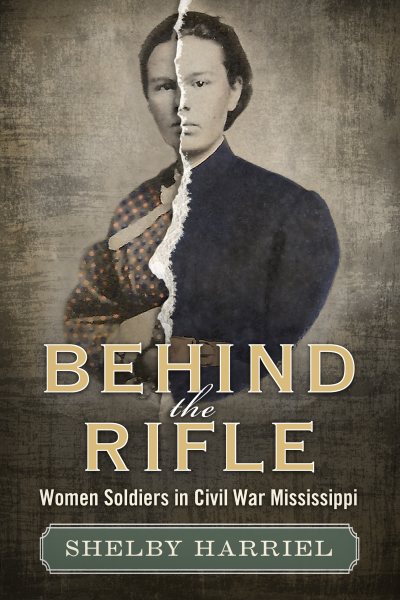Interview by Jana Hoops. Special to the Clarion-Ledger Sunday print edition (April 14)
Shelby Harriel fell in love with history at a young age when she was shocked to find out that her own state had left its country in order to start a new one.
 That curiosity eventually led to published research in newspapers, magazine, website, and blogs about the role of women in the Civil War.
That curiosity eventually led to published research in newspapers, magazine, website, and blogs about the role of women in the Civil War.
Her new book, Behind the Rifle: Women Soldiers in Civil War Mississippi (University Press of Mississippi) encompasses much of that information, with an emphasis on women’s motivation to secretly join the military and fight, the hard work they put in alongside the men in their units, and the roads they paved for a future for women in the military.
By day, Harriel may be found at Pearl River Community College in Poplarville–teaching . . . math!
Please tell me about your long interest in history–and specifically, the Civil War and women who fought in the Civil War. Do you have an approximate number or percentage on the fighting force that were women?

Shelby Harriel
I became interested in the Civil War in elementary school when we were first introduced to the subject in our Mississippi History class. I was absolutely fascinated to learn that my state had left the United States and formed a whole new country. I had to find out more. Eventually, my studies led me to participate in reenacting, but I just couldn’t find my niche. As an athlete my entire life … sitting on the sidelines in a hoop skirt never appealed to me. I was more interested in learning about the experiences of the common soldier.
One day, (someone) remarked that there were women who served as soldiers. Suddenly, I found a whole new exciting realm to direct my interest and research. That was in the late 1990s when researchers began to take a fresh new look at women soldiers, and books were published. So, I had all this new exciting material to consume. The more I read, the more questions I had. This naturally led to me examining primary sources myself. Soon, I had accumulated a great deal of new research that I felt needed a broader audience.
We will never know how many women served as soldiers during the Civil War because they were hidden behind male disguises. Estimates range from the hundreds to the thousands. When you consider that millions of men fought, this number is insignificant. There weren’t that many of them.
What motivated women–some as young as 16–to risk the dangers and hardships of war by secretly enlisting in the military and fighting in the Civil War, disguised as men–and how did they get through the physical exams that allowed them to pass as men?
In some cases, it was the same motivational factors that led men to enlist that also prompted women to join the ranks: patriotism, adventure, and economic opportunities. There weren’t many well-paying, respectable jobs available for women then. But when they disguised themselves as men, they could double or triple their income in a variety of jobs previously closed to them. This afforded them a more independent lifestyle they would not have been able to enjoy in traditional feminine roles. Women also enlisted to avoid separation from male loved ones who went off to war. Other women joined to escape these male family members. Vengeance for a fallen loved one led some women to enlist–or attempt to.
Military regulations called for a soldier to strip for a medical exam upon entering the service. However, pressure to fill depleting ranks or incompetency resulted in cursory examinations where, in some cases, all surgeons did was to ensure that a recruit had a working trigger finger and two good teeth to tear the paper cartridge that held the ammunition. There are quite a few accounts of soldiers testifying that all they had to do was to show their hands and teeth. Some women even had men take the exam for them. So it was actually not terribly difficult for a woman to get past the examination. There are accounts, however, of thorough examining surgeons discovering women trying to sneak into the ranks.
You point out several times in your book Behind the Rifle that pursuing research into the stories and even the names of women who fought in the Civil War is difficult. Could you explain why this was, and do you plan to continue your efforts to identify these women and tell their stories?
At the time, women could not serve in the military, so if a woman wanted to join the army, she had to disguise herself as a man. She cut her hair, put on male clothing, and assumed a male alias. It was actually not that difficult because they did not have forms of identification, but it was a risky venture. Back then, it was not only illegal but also socially unacceptable for a woman to even wear pants. If caught, she served jail time and/or paid a fine. Clothing defined the genders, and anybody caught crossing those lines brought shame upon themselves and their families.
If these women were caught, they often told newspaper reporters wrong information about themselves–including their own feminine name–so this information would not get back home to their families. Sometimes, writers would afford women privacy by not reporting their name, or by assigning them another alias. There is also evidence that the military may have expunged the records of women soldiers. There are instances where male soldiers were court martialed when women soldiers were discovered in their units. Therefore, it is not surprising that many people didn’t want these stories told–making it excruciatingly difficult for those who do want to tell them.
Yes, I plan to continue researching women soldiers because I think there is more to learn. All it takes is the discovery of one soldier’s letter or diary entry, or one newspaper article to provide a missing piece of the puzzle-such as a correct name–that will either bring that woman’s story to fruition or debunk it.
I plan to include new research in a second book on women soldiers. It will have a broader focus that will encompass all women soldiers of the Civil War, not just those with Mississippi connections.
All in all, what would you say these women, who fought on both sides, contributed to the war effort–and why do we need to know about them?
As mentioned earlier, they were statistically irrelevant. Their presence on the battlefield didn’t change the course of an engagement or the war. They weren’t there promoting social change. They weren’t feminists fighting for women’s rights. These women were simply uncommon soldiers experiencing the common trials of war alongside men. They performed the same duties as men, endured the same hardships. They suffered debilitating wounds. They sacrificed their lives for causes that men shared. And we should honor them all the same. These women soldiers helped pave the way for women to serve in our current military.
Shelby Harriel will be at Lemuria on Saturday, May 4, at 2:00 p.m. to sign and discuss Behind the Rifle: Women Soldiers in Civil War Mississippi.


Comments are closed.